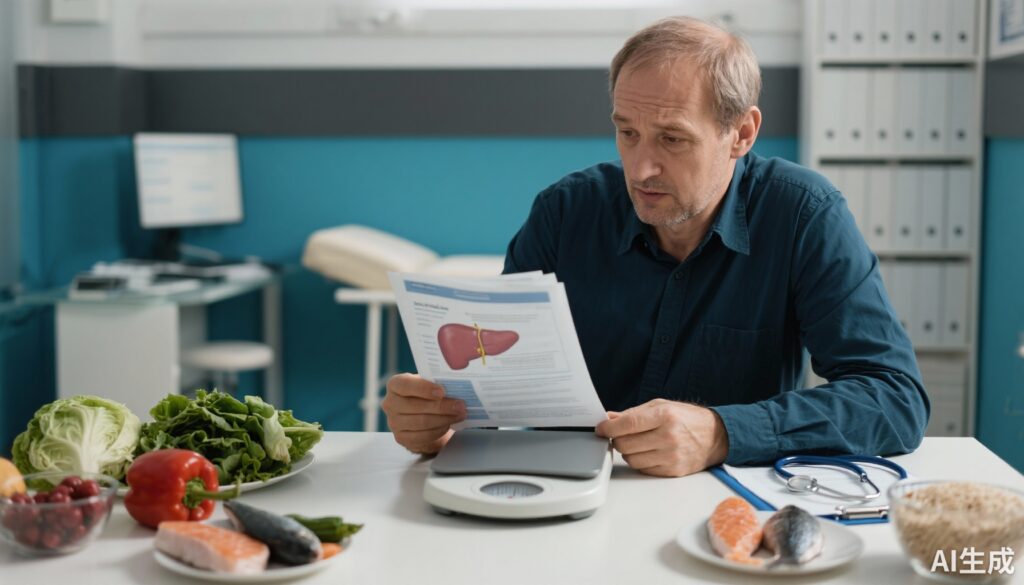Introduction
Fatty liver disease has emerged as a prevalent health concern worldwide, frequently appearing in modern health check-up reports. With sedentary lifestyles and rising obesity rates, many individuals are becoming more aware of the importance of dietary choices in managing or reversing this condition. However, despite earnest efforts to “eat healthy” and lose weight, paradoxical worsening of fatty liver has been reported in some cases. Why does the condition sometimes deteriorate even as body weight decreases? This article explores the complex relationship between diet, weight loss, and fatty liver progression, emphasizing the crucial role of balanced nutrition.
Understanding Fatty Liver Disease and Its Risks
Fatty liver, medically known as hepatic steatosis, results from the excessive accumulation of fat within liver cells. This disrupts normal liver metabolism and function. Early on, patients may experience no noticeable symptoms, and liver function tests can remain within normal ranges, leading to underestimation of the disease’s severity.
Over time, persistent fat accumulation can cause liver cell damage, triggering inflammation and fibrosis (scarring). This may progress to cirrhosis, liver failure, and significantly increases the risk of developing liver cancer (hepatocellular carcinoma).
Moreover, patients with fatty liver disease often face heightened risks of metabolic syndrome, type 2 diabetes mellitus, and cardiovascular diseases within 5 to 10 years. In some cases, severe complications such as heart attacks and strokes may occur within just 1 to 3 years. Thus, early intervention and effective management are critical.
Can Weight Loss Alone Improve Fatty Liver? The Surprising Answer
Weight loss is widely recognized as a primary treatment goal for fatty liver disease, particularly for those who are overweight or obese. Yet, paradoxically, some individuals report that their liver condition worsened despite losing body weight through strict dieting.
Take, for example, the case of John, a middle-aged man recently diagnosed with mild fatty liver during a routine check-up. Motivated to improve his health, John swapped his regular meals for exclusively boiled vegetables and whole grains. Over three months, he successfully shed several pounds. However, repeat liver imaging revealed his fatty liver had progressed to moderate severity.
Why did this happen?
Misconceptions About Diet in Fatty Liver Management
John’s case highlights a common misconception: that simply reducing calorie intake by eating only vegetables and grains is sufficient to reverse fatty liver. While calorie restriction helps with weight loss, it can create unintended nutritional imbalances that exacerbate liver fat accumulation.
Doctors explain that insufficient protein intake hampers the liver’s ability to export fat. The liver packages fats into molecules called lipoproteins, which require adequate high-quality protein to form and transport fats out of the liver. Without enough protein—typically from sources such as lean meats, eggs, dairy, and soy products—fat accumulates within liver cells, worsening steatosis.
Additionally, prolonged fasting or inadequate meal timing can trigger the body to break down fats and proteins from other tissues to maintain blood glucose levels. This influx of fatty acids to the liver can increase fat deposition, further aggravating fatty liver.
Thus, a diet consisting solely of boiled vegetables and grains, though seemingly healthy, may inadvertently promote liver fat buildup if it lacks proper protein and other nutrients.
The Cornerstones of Effective Nutritional Management for Fatty Liver
Managing fatty liver requires a holistic approach to nutrition that balances macronutrients (proteins, fats, carbohydrates) and ensures sufficient vitamins and minerals. Here are eight golden dietary principles to guide those with fatty liver:
1. Moderate Energy Intake & Adequate Satiety
Excess calorie intake promotes liver fat synthesis. Aim for controlled energy consumption, preferably reducing daily caloric intake by 300–500 kcal for overweight individuals. Eat until about 80% full, and prioritize low-calorie, nutrient-dense foods.
2. High-Quality Protein
Protein supports liver cell repair and regenerates damaged tissue. Good sources include skim milk products, egg whites, fish, skinless poultry, and soy-based foods.
3. Choose Healthy Fats
Avoid animal fats like lard, butter, and fried foods. Limit high-fat animal organs and cholesterol-rich foods (intake under 300 mg cholesterol/day). Favor plant-based oils and omega-3 rich foods such as fatty fish, flaxseed oil, and olive oil, which reduce inflammation and liver fat.
4. Carbohydrate Quality and Balance
Limit refined carbohydrates—white rice, bread, sugary drinks—that stimulate insulin and increase liver triglyceride synthesis. Combine whole grains and coarse grains to improve metabolic responses.
5. Increase Dietary Fiber & Choose Low-Fructose Fruits
Fiber-rich foods such as whole grains, legumes, vegetables, and mushrooms improve digestion and regulate blood sugar. Opt for low-fructose fruits like lemons, grapefruit, cherries, and apples (200-300 g daily).
6. Minimal Use of Seasonings & Cooking Methods
Limit salt (5–6 g/day), avoid spicy and appetite-stimulating condiments, and prefer cooking methods like steaming, boiling, stewing, or light stir-frying over frying or deep-frying.
7. Time-Restricted Eating
Emerging studies (e.g., published June 2025 in the Journal of Hepatology) highlight benefits of intermittent fasting or time-restricted feeding, such as eating only within an 8-hour window daily (e.g., 9 AM to 5 PM). This “16+8” regimen showed a 23.7% reduction in liver fat in 4 months, alongside weight loss and metabolic improvements.
8. Absolute Abstinence from Alcohol & Medication Caution
Alcohol metabolism burden heavily taxes the liver, exacerbating fatty liver changes. Avoid alcohol entirely and use liver supplements or medications only under medical guidance.
Illustrative Case: John’s Path to Recovery
After discussing his diet with a hepatologist and a dietitian, John adjusted his eating plan. He incorporated moderate amounts of lean chicken, egg whites, and fish, balanced with whole grains and a variety of vegetables. He limited salt and avoided snacking outside the 9 AM to 5 PM window.
After six months, follow-up imaging showed significant improvement in liver fat. John experienced stable weight loss and better energy.
This case exemplifies how nuanced dietary strategies, rather than strict or overly simplistic regimens, promote liver health.
Conclusion
Fatty liver disease management extends beyond weight loss alone; it demands balanced nutrition tailored to liver metabolism and individual needs. Simply restricting calories or skipping key nutrients like proteins can paradoxically worsen hepatic steatosis.
Patients should embrace a multidisciplinary approach combining moderated energy intake, high-quality proteins, healthy fats, controlled carbohydrates, adequate fiber, and mindful meal timing. Avoiding alcohol and unregulated supplements is vital.
Ongoing research like time-restricted feeding offers promising adjunct strategies, but personalized medical advice remains paramount.
Understanding these principles empowers individuals to make informed choices, effectively controlling and potentially reversing fatty liver disease while safeguarding overall health.
References
1. Friedman SL, Neuschwander-Tetri BA, Rinella M, Sanyal AJ. Mechanisms of NAFLD development and therapeutic strategies. Nat Med. 2018;24(7):908-922.
2. Leung C, Rivera L, Furness JB, Angus PW. The role of the gut microbiota in NAFLD. Nat Rev Gastroenterol Hepatol. 2016;13(7):412-425.
3. Luukkonen PK, Qadri SS, Arola J, et al. Time-restricted feeding decreases hepatic steatosis: A study published June 2025 in Journal of Hepatology.
4. EASL–EASD–EASO Clinical Practice Guidelines for the management of non-alcoholic fatty liver disease, Journal of Hepatology, 2016.
5. Chalasani N, Younossi Z, Lavine JE, et al. The diagnosis and management of non-alcoholic fatty liver disease: Practice guidance from the American Association for the Study of Liver Diseases. Hepatology. 2018;67(1):328-357.

